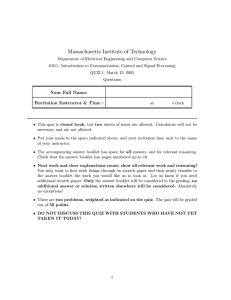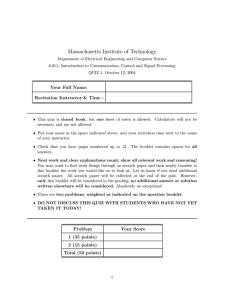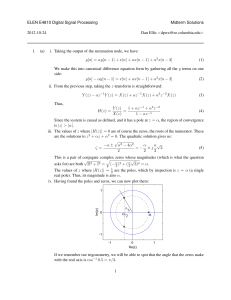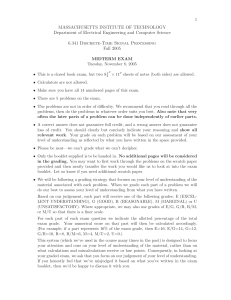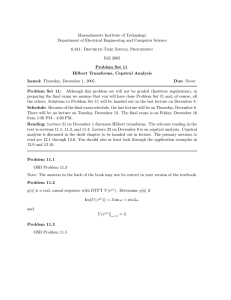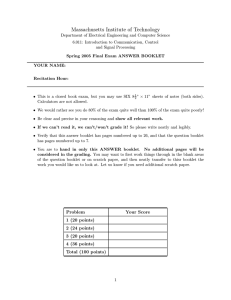Massachusetts Institute of Technology
advertisement
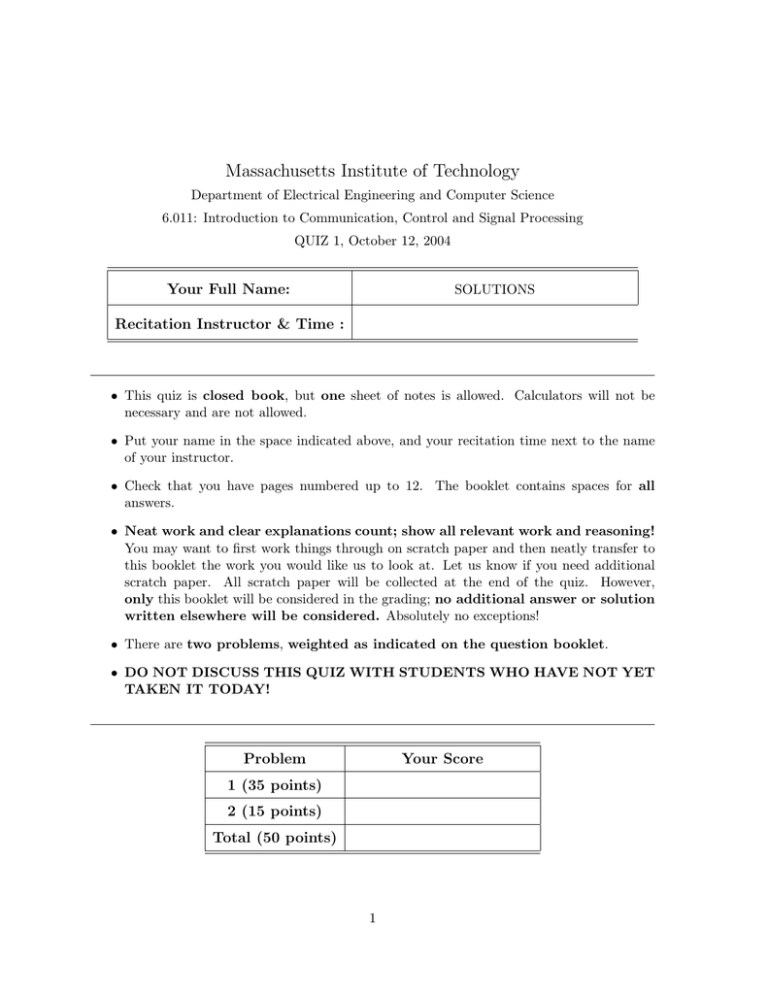
Massachusetts Institute of Technology
Department of Electrical Engineering and Computer Science
6.011: Introduction to Communication, Control and Signal Processing
QUIZ 1, October 12, 2004
Your Full Name:
SOLUTIONS
Recitation Instructor & Time :
• This quiz is closed book, but one sheet of notes is allowed. Calculators will not be
necessary and are not allowed.
• Put your name in the space indicated above, and your recitation time next to the name
of your instructor.
• Check that you have pages numbered up to 12. The booklet contains spaces for all
answers.
• Neat work and clear explanations count; show all relevant work and reasoning!
You may want to first work things through on scratch paper and then neatly transfer to
this booklet the work you would like us to look at. Let us know if you need additional
scratch paper. All scratch paper will be collected at the end of the quiz. However,
only this booklet will be considered in the grading; no additional answer or solution
written elsewhere will be considered. Absolutely no exceptions!
• There are two problems, weighted as indicated on the question booklet.
• DO NOT DISCUSS THIS QUIZ WITH STUDENTS WHO HAVE NOT YET
TAKEN IT TODAY!
Problem
Your Score
1 (35 points)
2 (15 points)
Total (50 points)
1
6.011
Quiz 1, October 12, 2004
Problem 1 (35 points)
1(a) (10 points) The frequency response of a particular DT LTI system is
H(ejΩ ) =
ej2Ω
.
1 − 12 e−jΩ
Determine its unit­sample response h[n]. (If you do this correctly, you will find that the system
is neither causal nor anti­causal.) Also determine
∞
�
�
h[k]
and
π
|H(ejΩ )|2 dΩ .
0
k=−∞
Caution: You need to get the value of the integral exactly right to get credit for that part, so
read carefully to see what is asked — and evaluate the integral without doing any integration!
It may help you to recall that
∞
�
ri =
i=0
1
,
1−r
|r| < 1 .
Begin work for 1(a) here:
First, find h[n]:
H(z) =
�
�
z2
1 −1
1 2 −2
2
z
+
(
)
z
+
...
=
z
1
+
2
2
1 − 12 z −1
� �n+2
1
h[n] =
u[n + 2]
2
Next, compute:
∞
�
1
h[k] = 1 + +
2
−∞
� �2
1
1
+ ... =
2
1−
OR
∞
�
h[k] = H(ej0 ) = 2
−∞
2
1
2
=2
6.011
Quiz 1, October 12, 2004
Lastly, find:
�
0
π
2π
|H (e )| dΩ =
2
jΩ 2
�
1
2π
�
π
jΩ 2
|H(e )| dΩ
−π
By Parseval’s theorem:
�
� ∞
�
�
� �2
�
π
2π
1
1
2
+ ... =
=
h [k] = π 1 + +
2
4
4
1−
k=−∞
� �n+2
1
h[n] =
u[n + 2]
2
∞
�
h[k] = 2
−∞
�
π
|H (ejΩ )|2 dΩ =
0
3
�
4π
3
1
4
=
4π
3
6.011
Quiz 1, October 12, 2004
1(b) (5 points) If x[n] denotes a wide­sense stationary process with mean value µx and auto­
covariance function Cxx [m] = σx2 δ[m], what is the linear minimum mean­square­error (LMMSE)
estimate of x[n + 2] in terms of x[n]? In other words, find α and β in x
�[n + 2] = αx[n] + β such
2
that E{(x[n + 2] − x
�[n + 2]) } is minimized. Also find the associated (minimum) mean square
error (MSE).
Work to be looked at:
x̂[n + 2] = µx +
Cxx [2]
(x[n] − µx )
Cxx [0]
But, we know that:
Cxx [2] = 0
Therefore,
x
ˆ[n + 2] = µx
Thus, α = 0 and β = µx .
The associated MMSE is:
M M SE = var (x[n + 2]) = Cxx [0] = σx2
Note that the general expression for MMSE is given as:
�
�
σx2 1 − ρ2
but in this case, ρ = 0.
α=0
β = µx
MSE = σx2
4
6.011
Quiz 1, October 12, 2004
1(c) (10 points) If the process x[n] in 1(b) is applied to the input of the system in 1(a),
what is the power spectral density Syy (ejΩ ) of the output process y[n]? Also evaluate E{y[n]},
E{y 2 [n]}, and
N
�
1
lim
y[k] .
N →∞ 2N + 1
k=−N
Begin work for 1(c) here.
First find the PSD of y[n]:
Rxx [m] = Cxx [m] + µ2x
� �
Sxx ejΩ = σx2 + 2πµ2x δ (Ω)
� � � � ��2
� � �
�
Syy ejΩ = �H ejΩ � Sxx = H ejΩ H e−jΩ Sxx =
� �
Syy ejΩ =
5
4
e−j2Ω
ej2Ω
Sxx
1 − 12 e−jΩ 1 − 12 ejΩ
Sxx
σ 2 + 2πµx2 δ (Ω)
= x5
+ cos Ω
4 + cos Ω
Second, find E(y[n]):
� �
E(y[n]) = µx H ej0 = 2µx
Third, find E(y 2 [n]):
1
E(y [n]) = Ryy [0] =
2π
2
E(y 2 [n]) =
2
E(y [n]) =
σx2
�
1
2π
�
π
�
jΩ
Syy e
−π
1
2π
�
π
−π
�
�
1
dΩ =
2π
�
π
� � � � ��2
Sxx ejΩ �H ejΩ � dΩ
−π
� � � ��2
σx2 + 2πµx2 δ (Ω) �H ejΩ � dΩ
�
� π
� � j٠��2
� � ��2
�H e � dΩ + 1
2πµx2 δ(Ω) �H ejΩ � dΩ
2π −π
−π
�
π
� � ��2 4σ 2
4σx2
+ µ2x �H ej0 � = x + 4µx2
3
3
Lastly, compute using ergodicity:
E(y 2 [n]) =
N
�
1
y[k] = µy = 2µx
lim
N →∞ 2N + 1
k=−N
5
6.011
Quiz 1, October 12, 2004
.
Syy (ejΩ ) =
2 +2πµ2 δ(Ω)
σx
x
5
+cos Ω
4
E{y 2 [n]} =
E{y [n]} = 2µx
limN →∞
1
2N +1
�N
k=−N
y[k] = 2µx
6
2
4σx
3
+ 4µ
2
x
6.011
Quiz 1, October 12, 2004
Caution: Make sure you move on to Problem 2 if you find yourself taking too long or
getting stuck in part 1(d) below.
1(d) (10 points) With all quantities as previously defined, and assuming µx = 0 for simplicity,
suppose what you can measure is q[n] = y[n] + v[n] for all n, where v[n] is (zero­mean) white
noise of intensity σv2 , and is uncorrelated with the process x[k]. Compute the frequency response
W (ejΩ ) of the non­causal Wiener filter that has q[n] as input at time n and produces the LMMSE
estimate x
�[n + 2] as output at time n. Explicitly check that your answer reduces to something
that you expect in the case that σv2 = 0.
Begin work for 1(d) here.
Let g[n] = x[n + 2]
� jΩ �
�
e
S
gq
W ejΩ =
Sqq (ejΩ )
�
Since y and v are uncorrelated (since x and v are uncorrelated), we have:
Sqq = Syy + Svv = HH ∗ σx2 + σv2
Since g and v are uncorrelated, we also have that:
Sgq = Sgy
Making use of the fact that g[n] = x[n + 2], we can say:
Sgy = e2jΩ Sxy = e2jΩ H ∗ σx2
Putting it all together, we have:
� �
W ejΩ =
�
�
ej2Ω H e−jΩ σx2
H (ejΩ ) H (e−jΩ ) σx2 + σv2
7
6.011
Quiz 1, October 12, 2004
.
� �
W ejΩ =
When σv2 = 0, this becomes:
�
�
ej2Ω H e−jΩ σx2
H (ejΩ ) H (e−jΩ ) σx2 + σv2
ej2Ω
H (ejΩ )
Which is reasonable because: This is the inverse system to get x[n] from y[n], then advance
by 2 steps, to get x[n + 2].
8
6.011
Quiz 1, October 12, 2004
Problem 2 (15 points)
2(a) (5 points) Suppose q1 (t) is obtained from x1 (t) by filtering through a stable system with
frequency response 1−jω
1+jω , and q2 (t) is obtained from x2 (t) by filtering through another stable
system with the same frequency response 1−jω
1+jω . Express the cross­spectral density Sq1 q2 (jω) in
terms of Sx1 x2 (jω). (Assume x1 and x2 are jointly wide­sense­stationary.)
Sq1 q2 (jω) = H (jΩ) H ∗ (jΩ) Sx1 x2
�
��
�
1 − jω
1 + jω
Sq1 q2 (jω) =
Sx1 x2 (jω) = Sx1 x2 (jω)
1 + jω
1 − jω
Sq1 q2 (jω) = Sx1 x2 (jω)
9
6.011
Quiz 1, October 12, 2004
2(b) (10 points) For each of the following functions R[m], state whether or not it can be the
autocorrelation function of a DT WSS random process, where m denotes the lag. If it cannot
be, explain why not. If it can be, explain in detail how you would obtain such a process by
appropriately filtering a Bernoulli process that takes values at each time instant of +1 or −1,
with equal probability.
(i) R[m] = 1 for m = 0, 0.7 for |m| = 1, and 0 elsewhere.
(ii) R[m] = 2 for m = 0, −1 for |m| = 1, and 0 elsewhere.
2(b)(i) R[m] = 1 for m = 0, 0.7 for |m| = 1, and 0 elsewhere:
Begin work here:
There are three easy criteria we can check for this candidate:
1. Is R[m] an even function of m, i.e. is R[m] = R[−m]? YES
2. Is |R[m]| ≤ |R[0]|? YES
3. Is the PSD always non­negative? NO, see work below.
�
ejΩ + e−jΩ
F (R[m]) = S(e ) = 1 + 1.4
= 1 + 1.4 cos Ω
2
�
jΩ
In the above expression, S(ejΩ ) can be negative for some Ω, and therefore it cannot be a
valid PSD.
Thus, R[m] CANNOT be a valid autocorrelation function.
10
6.011
Quiz 1, October 12, 2004
2(b)(ii) R[m] = 2 for m = 0, −1 for |m| = 1, and 0 elsewhere:
Begin work here:
There are three easy criteria we can check for this candidate:
1. Is R[m] an even function of m, i.e. is R[m] = R[−m]? YES
2. Is |R[m]| ≤ |R[0]|? YES
3. Is the PSD always non­negative? YES, see work below.
�
ejΩ + e−jΩ
F (R[m]) = S(e ) = 2 + 2
= 2 + 2cosΩ
2
�
jΩ
In the above expression, S(ejΩ ) is non­negative for all Ω, and therefore it CAN be a valid
PSD. Thus, R[m] CAN be a valid autocorrelation function.
To actually demonstrate that it is valid, we now show how to generate a process with this
autocorrelation function, by appropriate LTI filtering of a Bernoulli process, with zero mean
and autocorrelation δ[m]. We need to find h[m] such that h[m] ∗ h[−m] = R[m]. The following
filter will work for any integer value of l:
h[n] = ± (δ[n − l] − δ[n − l − 1])
You can also obtain an expression for the filter H(ejΩ ) in the frequency domain as:
H(jΩ)H(−jΩ) = 2 + 2 cos Ω
H (jΩ) = 1 − e−jΩ
11
6.011
Quiz 1, October 12, 2004
Additional work:
12
